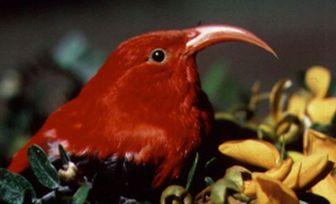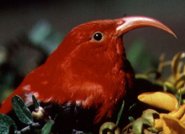'I'iwi
The adult ʻiʻiwi is mostly fiery red, with black wings and tail and a long, curved, salmon-colored bill used primarily for drinking nectar. The contrast of the red and black plumage with surrounding green foliage makes the ʻiʻiwi one of the most easily seen Hawaiian birds. Younger birds have a more spotted golden plumage and ivory bills and were mistaken for a different species by early naturalists on Hawaiʻi. The ʻiʻiwi, even though it was used in the feather trade, was less affected than the Hawai'i mamo because the ʻiʻiwi was not as sacred to the Hawaiians. The ʻiʻiwi's feathers were highly prized by Hawaiian aliʻi for use in decorating ʻahuʻula and mahiole , and such uses gave the species its scientific name: vestiaria, which comes from the Latin for clothing, and coccinea means scarlet-colored. The bird is also often mentioned in Hawaiian folklore. The Hawaiian song Sweet Lei Mamo includes the line The i'iwi bird, too, is a friend. The bird is capable of hovering in the air, much like hummingbirds. I

'I'iwi - Partner in Avian Preservation
 The 'I'iwi (Vestiaria coccinea) is a bright red orange bird with similarities to hummingbirds found in Hawaii. They drink nectar of Hawaiian lobelia flowers with their long bills, but unlike hummingbirds, their bills are curved. They will also dine on small crustaceans, butterflies, and other insects if nectar is hard to find. They can also hover like hummingbirds. Another name for them is the Hawaiian honeycreeper.
The 'I'iwi (Vestiaria coccinea) is a bright red orange bird with similarities to hummingbirds found in Hawaii. They drink nectar of Hawaiian lobelia flowers with their long bills, but unlike hummingbirds, their bills are curved. They will also dine on small crustaceans, butterflies, and other insects if nectar is hard to find. They can also hover like hummingbirds. Another name for them is the Hawaiian honeycreeper.
Many have seen old pictures of Hawaiians wearing feathered capes and head dresses in bright red. Those feathers are from the 'I' iwi when it becomes an adult. It is only a matter of 2 weeks before the eggs are hatched. Adulthood is reached almost as rapidly in less than a month. They grow to about 15 centimeters or almost 6 inches in length, and weigh about 17 grams or about half an ounce. When newly hatched, their down is pale lime colored with rusty splotches. As this grows out, they molt into their adult coloring. They have black wings and with very little white near their wing area. Their legs are even bright red orange.
The little birds' survival rate is better in high altitudes because the mosquito population that causes avian malaria is not present there. When migrating to lower altitudes, they may face other avian diseases. Land and habitat alterations have also declined numbers. Because of maladies faced, they are extinct on one Hawaiian island and only survive in higher numbers on two others. One way scientists are trying to preserve the species is by elimination of non-native environmental factors. Predatory feral cats and rats are two other hazards of the 'i'iwi.
Besides its own existence, it has been used to help other native species of birds that may be in peril in the Hawaiian islands, such as the endangered akohekohe bird. Scientists captured 'i'iwi birds using two ways called hard and soft methods. Each was studied to see survival rates of reintroduced birds. Hard method was a quick catch, tag, and release to a new area, whereas, soft method added a period of week long captivity and feeding of artificial nectar before release. Radio monitors traced information from the released birds, and used to relocate akohekohe to try to build their populations, too. The scientific community is in hopes that both of these birds' numbers will increase enough that they will no longer be considered endangered to the world.
The 'I'iwi is classified as Vulnerable (VU), considered to be facing a high risk of extinction in the wild.

Original source: Caleb Slemmons
-Caleb Slemmons -Author: Caleb Slemmons
Permission: Some rights reserved
Family : Fringillidae
Genus : Vestiaria
Species : coccinea
Authority : (Forster, 1780)

